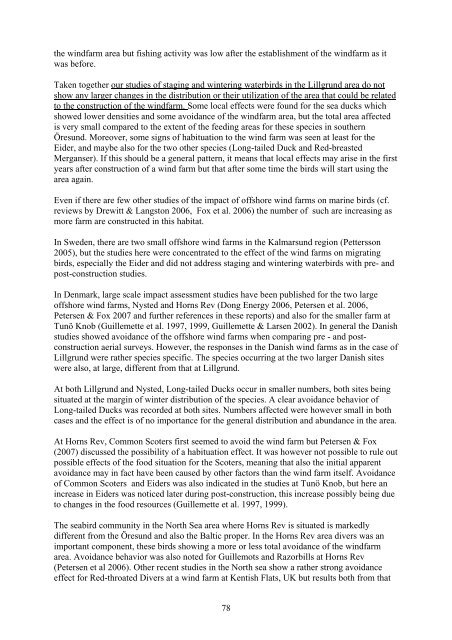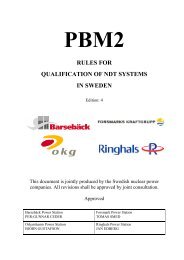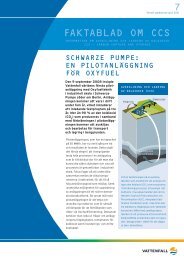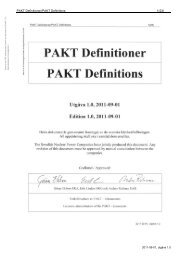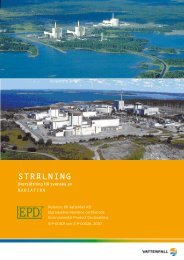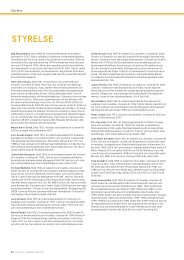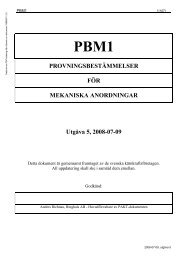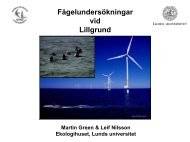Birds in southern Öresund in relation to the wind farm at ... - Vattenfall
Birds in southern Öresund in relation to the wind farm at ... - Vattenfall
Birds in southern Öresund in relation to the wind farm at ... - Vattenfall
You also want an ePaper? Increase the reach of your titles
YUMPU automatically turns print PDFs into web optimized ePapers that Google loves.
<strong>the</strong> w<strong>in</strong>d<strong>farm</strong> area but fish<strong>in</strong>g activity was low after <strong>the</strong> establishment of <strong>the</strong> w<strong>in</strong>d<strong>farm</strong> as it<br />
was before.<br />
Taken <strong>to</strong>ge<strong>the</strong>r our studies of stag<strong>in</strong>g and w<strong>in</strong>ter<strong>in</strong>g w<strong>at</strong>erbirds <strong>in</strong> <strong>the</strong> Lillgrund area do not<br />
show any larger changes <strong>in</strong> <strong>the</strong> distribution or <strong>the</strong>ir utiliz<strong>at</strong>ion of <strong>the</strong> area th<strong>at</strong> could be rel<strong>at</strong>ed<br />
<strong>to</strong> <strong>the</strong> construction of <strong>the</strong> w<strong>in</strong>d<strong>farm</strong>. Some local effects were found for <strong>the</strong> sea ducks which<br />
showed lower densities and some avoidance of <strong>the</strong> w<strong>in</strong>d<strong>farm</strong> area, but <strong>the</strong> <strong>to</strong>tal area affected<br />
is very small compared <strong>to</strong> <strong>the</strong> extent of <strong>the</strong> feed<strong>in</strong>g areas for <strong>the</strong>se species <strong>in</strong> <strong>sou<strong>the</strong>rn</strong><br />
<strong>Öresund</strong>. Moreover, some signs of habitu<strong>at</strong>ion <strong>to</strong> <strong>the</strong> w<strong>in</strong>d <strong>farm</strong> was seen <strong>at</strong> least for <strong>the</strong><br />
Eider, and maybe also for <strong>the</strong> two o<strong>the</strong>r species (Long-tailed Duck and Red-breasted<br />
Merganser). If this should be a general p<strong>at</strong>tern, it means th<strong>at</strong> local effects may arise <strong>in</strong> <strong>the</strong> first<br />
years after construction of a w<strong>in</strong>d <strong>farm</strong> but th<strong>at</strong> after some time <strong>the</strong> birds will start us<strong>in</strong>g <strong>the</strong><br />
area aga<strong>in</strong>.<br />
Even if <strong>the</strong>re are few o<strong>the</strong>r studies of <strong>the</strong> impact of offshore w<strong>in</strong>d <strong>farm</strong>s on mar<strong>in</strong>e birds (cf.<br />
reviews by Drewitt & Langs<strong>to</strong>n 2006, Fox et al. 2006) <strong>the</strong> number of such are <strong>in</strong>creas<strong>in</strong>g as<br />
more <strong>farm</strong> are constructed <strong>in</strong> this habit<strong>at</strong>.<br />
In Sweden, <strong>the</strong>re are two small offshore w<strong>in</strong>d <strong>farm</strong>s <strong>in</strong> <strong>the</strong> Kalmarsund region (Pettersson<br />
2005), but <strong>the</strong> studies here were concentr<strong>at</strong>ed <strong>to</strong> <strong>the</strong> effect of <strong>the</strong> w<strong>in</strong>d <strong>farm</strong>s on migr<strong>at</strong><strong>in</strong>g<br />
birds, especially <strong>the</strong> Eider and did not address stag<strong>in</strong>g and w<strong>in</strong>ter<strong>in</strong>g w<strong>at</strong>erbirds with pre- and<br />
post-construction studies.<br />
In Denmark, large scale impact assessment studies have been published for <strong>the</strong> two large<br />
offshore w<strong>in</strong>d <strong>farm</strong>s, Nysted and Horns Rev (Dong Energy 2006, Petersen et al. 2006,<br />
Petersen & Fox 2007 and fur<strong>the</strong>r references <strong>in</strong> <strong>the</strong>se reports) and also for <strong>the</strong> smaller <strong>farm</strong> <strong>at</strong><br />
Tunö Knob (Guillemette et al. 1997, 1999, Guillemette & Larsen 2002). In general <strong>the</strong> Danish<br />
studies showed avoidance of <strong>the</strong> offshore w<strong>in</strong>d <strong>farm</strong>s when compar<strong>in</strong>g pre - and postconstruction<br />
aerial surveys. However, <strong>the</strong> responses <strong>in</strong> <strong>the</strong> Danish w<strong>in</strong>d <strong>farm</strong>s as <strong>in</strong> <strong>the</strong> case of<br />
Lillgrund were ra<strong>the</strong>r species specific. The species occurr<strong>in</strong>g <strong>at</strong> <strong>the</strong> two larger Danish sites<br />
were also, <strong>at</strong> large, different from th<strong>at</strong> <strong>at</strong> Lillgrund.<br />
At both Lillgrund and Nysted, Long-tailed Ducks occur <strong>in</strong> smaller numbers, both sites be<strong>in</strong>g<br />
situ<strong>at</strong>ed <strong>at</strong> <strong>the</strong> marg<strong>in</strong> of w<strong>in</strong>ter distribution of <strong>the</strong> species. A clear avoidance behavior of<br />
Long-tailed Ducks was recorded <strong>at</strong> both sites. Numbers affected were however small <strong>in</strong> both<br />
cases and <strong>the</strong> effect is of no importance for <strong>the</strong> general distribution and abundance <strong>in</strong> <strong>the</strong> area.<br />
At Horns Rev, Common Scoters first seemed <strong>to</strong> avoid <strong>the</strong> w<strong>in</strong>d <strong>farm</strong> but Petersen & Fox<br />
(2007) discussed <strong>the</strong> possibility of a habitu<strong>at</strong>ion effect. It was however not possible <strong>to</strong> rule out<br />
possible effects of <strong>the</strong> food situ<strong>at</strong>ion for <strong>the</strong> Scoters, mean<strong>in</strong>g th<strong>at</strong> also <strong>the</strong> <strong>in</strong>itial apparent<br />
avoidance may <strong>in</strong> fact have been caused by o<strong>the</strong>r fac<strong>to</strong>rs than <strong>the</strong> w<strong>in</strong>d <strong>farm</strong> itself. Avoidance<br />
of Common Scoters and Eiders was also <strong>in</strong>dic<strong>at</strong>ed <strong>in</strong> <strong>the</strong> studies <strong>at</strong> Tunö Knob, but here an<br />
<strong>in</strong>crease <strong>in</strong> Eiders was noticed l<strong>at</strong>er dur<strong>in</strong>g post-construction, this <strong>in</strong>crease possibly be<strong>in</strong>g due<br />
<strong>to</strong> changes <strong>in</strong> <strong>the</strong> food resources (Guillemette et al. 1997, 1999).<br />
The seabird community <strong>in</strong> <strong>the</strong> North Sea area where Horns Rev is situ<strong>at</strong>ed is markedly<br />
different from <strong>the</strong> <strong>Öresund</strong> and also <strong>the</strong> Baltic proper. In <strong>the</strong> Horns Rev area divers was an<br />
important component, <strong>the</strong>se birds show<strong>in</strong>g a more or less <strong>to</strong>tal avoidance of <strong>the</strong> w<strong>in</strong>d<strong>farm</strong><br />
area. Avoidance behavior was also noted for Guillemots and Razorbills <strong>at</strong> Horns Rev<br />
(Petersen et al 2006). O<strong>the</strong>r recent studies <strong>in</strong> <strong>the</strong> North sea show a ra<strong>the</strong>r strong avoidance<br />
effect for Red-thro<strong>at</strong>ed Divers <strong>at</strong> a w<strong>in</strong>d <strong>farm</strong> <strong>at</strong> Kentish Fl<strong>at</strong>s, UK but results both from th<strong>at</strong><br />
78


